| |
| ... |
|
|
|
|
|
| |
| December 13, 2005 |
|
Isurus retroflexus
This past summer, Pat and I began a project to reconstruct an Isurus retroflexus tooth-set using Pungo River material. The project extended into the fall as we concluded there were two forms that needed to be addressed. With that said, we think the paper and accompanying reconstructions will be of interest. These pages have been added to the "Isurus Dentition" slide-show.
|
| December 10, 2005 |
|
Fossil Tooth-sets
Buried in elasmo.com are several fossil tooth-set reconstructions. Since it is expected that additional ones will be added in the next month-or-so, it seemed useful that there be a common interface to access them directly. Therefore, a new slide-show has been created for that purpose -- it is hoped you find it useful.
|
| December 3-4, 2005 |
|
Weekend 11: The Season Comes to a Close
Pat Young reports: The final collecting weekend at Aurora was a study in contrasts. Saturday's visitors, from the snowbound north, were greeted with a familiar sight -- a heavy frost blanketed the Aurora area. Sunday's group however enjoyed 70-degree temps and brisk southerly breezes all day.
Saturday's group consisted of Friends of the University of Michigan Museum of Paleontology and Johns Hopkins University Fossil Club while the Delaware Valley Earth Science Society and Duke University had Sunday's slots. Several non-club collectors were also present on both days.
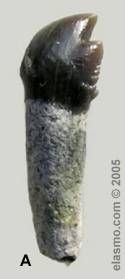 This late in the season, large megalodon teeth are not a realistic priority. On Saturday, only two megs were reported, each were 1-1/4 inch teeth. Yorktown collecting was best represented by David Fisher's great Cosmopolitodus hastalis (broad-form, aka xiphodon) upper A3 (1-3/4"); although Sally Labadie came away with an unusually large (1-inch) Notorynchus upper. The Pungo was heavily collected and produced a 7-1/2 inch section of a Squalodon jaw, containing one pre-molar, for David Thompson. Ron Edwards hauled out a mini-boulder containing a Notorynchus symphyseal tooth (image B). A fellow collector, Bill Hummel, produced a rock saw in the parking lot (don't we all carry one) and made a nice bookend for Ron. Whale teeth were shown by Tim Windler (2-1/4" Pungo sperm) and David Bright (3-1/2" Squalodon incisor). Echinorhinus blakei were collected by Candace Holliday, Sharron Edwards and Gregg Walden. Stan Hyne and Keith Robertson both found Squatina teeth. George Powell wandered to the Croatan Fm. and found associated crab claws of Menippe mercenaria (Stone crab). Other fossils were the usual assortment of hemis, contortus, Notorynchus and the ever abundant carcharhinid teeth. This late in the season, large megalodon teeth are not a realistic priority. On Saturday, only two megs were reported, each were 1-1/4 inch teeth. Yorktown collecting was best represented by David Fisher's great Cosmopolitodus hastalis (broad-form, aka xiphodon) upper A3 (1-3/4"); although Sally Labadie came away with an unusually large (1-inch) Notorynchus upper. The Pungo was heavily collected and produced a 7-1/2 inch section of a Squalodon jaw, containing one pre-molar, for David Thompson. Ron Edwards hauled out a mini-boulder containing a Notorynchus symphyseal tooth (image B). A fellow collector, Bill Hummel, produced a rock saw in the parking lot (don't we all carry one) and made a nice bookend for Ron. Whale teeth were shown by Tim Windler (2-1/4" Pungo sperm) and David Bright (3-1/2" Squalodon incisor). Echinorhinus blakei were collected by Candace Holliday, Sharron Edwards and Gregg Walden. Stan Hyne and Keith Robertson both found Squatina teeth. George Powell wandered to the Croatan Fm. and found associated crab claws of Menippe mercenaria (Stone crab). Other fossils were the usual assortment of hemis, contortus, Notorynchus and the ever abundant carcharhinid teeth.
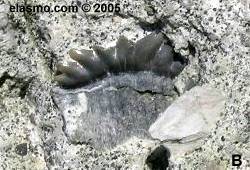 Sunday's group fared well; Joe Armstrong found a 3-3/16. chubutensis in Pungo limestone, then traveled to the James City, finding a sand dollar (Melitta sp.) Kerrie Green got two small megs (2" and 1-1/2") and Cyd Phillips a 1-1/4" specimen. Myrtle Williams got the largest hastalis of the day - a 1-5/8" lower. Pathological teeth were reported by Eleanor Williford (G. cuvier with a twisted cusp) and George Williams (a split-tip Alopias vulpinus). Dave Sanderson found a very pretty Squalodon molar. Jack Stiles started his fossil collecting hobby by finding a Notorynchus lower and several others were seen. One outstanding ?Phocogeneus venustus tooth was collected by a anonymous collector (image A). First time Aurora collectors Katherine Almquist (E. blakei dermal denticle), Jo Ann McEnerney (partial whale skull containing the periotic and posterior process), and Erica Ness (whale vertebra) were happy with their finds. Sunday's group fared well; Joe Armstrong found a 3-3/16. chubutensis in Pungo limestone, then traveled to the James City, finding a sand dollar (Melitta sp.) Kerrie Green got two small megs (2" and 1-1/2") and Cyd Phillips a 1-1/4" specimen. Myrtle Williams got the largest hastalis of the day - a 1-5/8" lower. Pathological teeth were reported by Eleanor Williford (G. cuvier with a twisted cusp) and George Williams (a split-tip Alopias vulpinus). Dave Sanderson found a very pretty Squalodon molar. Jack Stiles started his fossil collecting hobby by finding a Notorynchus lower and several others were seen. One outstanding ?Phocogeneus venustus tooth was collected by a anonymous collector (image A). First time Aurora collectors Katherine Almquist (E. blakei dermal denticle), Jo Ann McEnerney (partial whale skull containing the periotic and posterior process), and Erica Ness (whale vertebra) were happy with their finds.
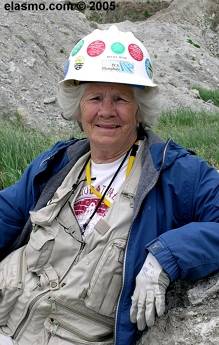 Although she'll be back for the Spring season, the presence of one collector was sorely missed this Fall. For more than 20 years, the name of Becky Hyne has been synonymous with the Lee Creek experience. Her nickname, Our Lady of the Yorktown, tells it all. No person has ever taken so much time to train fossil novices in the art of Lee Creek collecting. Nor has anyone has ever been so generous in sharing their own fossils; for many of us, our first big whale tooth or 'meg' came from Becky. She then took time to train us in our own quest for fossils at Aurora. Before information on Lee Creek fossils was widely available, Becky was the one to whom we always turned for help with identification. We still depend on her assistance with our marine mammal fossils. Her success with the Pungo crawl technique has inspired a new generation of collectors to seek the small and unusual. This season, we've all missed seeing Becky. Recovering nicely from leg surgery, there is no truth in the rumor that it was caused by the Pungo Crawl. Although she'll be back for the Spring season, the presence of one collector was sorely missed this Fall. For more than 20 years, the name of Becky Hyne has been synonymous with the Lee Creek experience. Her nickname, Our Lady of the Yorktown, tells it all. No person has ever taken so much time to train fossil novices in the art of Lee Creek collecting. Nor has anyone has ever been so generous in sharing their own fossils; for many of us, our first big whale tooth or 'meg' came from Becky. She then took time to train us in our own quest for fossils at Aurora. Before information on Lee Creek fossils was widely available, Becky was the one to whom we always turned for help with identification. We still depend on her assistance with our marine mammal fossils. Her success with the Pungo crawl technique has inspired a new generation of collectors to seek the small and unusual. This season, we've all missed seeing Becky. Recovering nicely from leg surgery, there is no truth in the rumor that it was caused by the Pungo Crawl.
As the fall season draws to a close, we'd like to thank the Mining and Public Affairs Departments of PCS Phosphate for their continued generosity in allowing us to pursue our quest for knowledge of a world long since vanished.
|
| November 26-27, 2005 |
|
Weekend 10: Carry a Camera
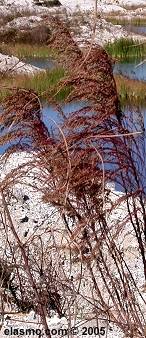 Pat Young reports: Gathering in the parking lot Saturday morning, the question most asked was how much rain there'd been the previous week. These collectors had traveled great distances and hopes were inflated. Delaware Mineralogical Society, Florida Fossil Hunters, Dry Dredgers (Ohio), Tampa Bay and Soutwest Florida Fossil Clubs made up the day's group. Tuesday's inch and a half of rain had exposed a few nice finds overlooked from last week's digging activities. Marge Fantozzi brought in the top C. megalodon of the day, a very nice 3-1/2" Yorktown tooth. Three small posterior ones were found by Ron Edwards, Eric Sadorf, and Keith Robertson. No C. chubutensis were reported. Cosmopolitodus hastalis (broad form) collectors faired better with those in the two inch range being found by Kim Sandoval (3), Gregg Walden, Norb Dunkle, Thomas Naxera, and Jason Sandoval. One large Notorynchus upper was found by BJ Blake and lowers by Sandy Lewis, James Duhadaway, and Keith Robertson. Thomas Naxera showed off the only Carcharodon carcharias (1-5/8" with a root), Ken Young and Eric Sadorf Squatina teeth and Gregg Walden a beautiful, tiny odontaspid. Other shark tooth finds were the usual small hemis, contortus, etc. Pat Young reports: Gathering in the parking lot Saturday morning, the question most asked was how much rain there'd been the previous week. These collectors had traveled great distances and hopes were inflated. Delaware Mineralogical Society, Florida Fossil Hunters, Dry Dredgers (Ohio), Tampa Bay and Soutwest Florida Fossil Clubs made up the day's group. Tuesday's inch and a half of rain had exposed a few nice finds overlooked from last week's digging activities. Marge Fantozzi brought in the top C. megalodon of the day, a very nice 3-1/2" Yorktown tooth. Three small posterior ones were found by Ron Edwards, Eric Sadorf, and Keith Robertson. No C. chubutensis were reported. Cosmopolitodus hastalis (broad form) collectors faired better with those in the two inch range being found by Kim Sandoval (3), Gregg Walden, Norb Dunkle, Thomas Naxera, and Jason Sandoval. One large Notorynchus upper was found by BJ Blake and lowers by Sandy Lewis, James Duhadaway, and Keith Robertson. Thomas Naxera showed off the only Carcharodon carcharias (1-5/8" with a root), Ken Young and Eric Sadorf Squatina teeth and Gregg Walden a beautiful, tiny odontaspid. Other shark tooth finds were the usual small hemis, contortus, etc.

Sunday's tooth hunters (non-club collectors) fared comparably with the largest YT meg being Matt Rever's tooth. Dug from three feet of soil, it lost a root ear in the process but still measured 3-1/2". Others were found by Bryan Butt (2-1/4" Pungo), Kelly Kiernan (1-1/2") and a very nice posterior by Zane Purvis. Broad-form hastalis in the two-inch range were found by Matt Rever, Colon Faulkenberry and Wendy Daniels; Christi Butt got a large narrow-form lower. Chris Daniels recovered a 2-inch C .carcharias and Deanna Daniels a Notorynchus lower.

Combining both days collecting reveals some unusually good finds for this late in the season. BJ and Marge each got great whale teeth (5+ inches) on Saturday while Sunday's collecting netted Kim Greene a 7-inch specimen. Other good finds were made by Dave Hoffman (complete whale humerus), black ray dermal scute (Neil Sapp), fish skin (Sophie Homsey), Ecphora shell (Sandy Lewis), Squalodon canine (Anne Lineberry), and a large whale caudal vertebra (Fred Hendershot). Searching Pungo sediments rewarded Bob Asreen with an extremely scarce internal core of an Aturia (cephalopod). Unfortunately, time did not allow for imaging. It's obvious that those leaving with the best finds are putting their Pungo crawl technique and their rakes to hard use.
Editors note: Slower collecting provides opportunities to capture images of the fauna, flora and some of the more interesting aspects of the mine (i.e. the Pungo reef image).
|
| November 19-20, 2005 |
|
Weekend 9: Changing Expectations
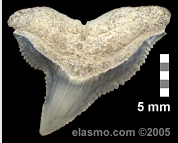 Pat Young reports: As late-season fossil collecting for larger teeth begins to wane, those still anxious for a Lee Creek experience begin to focus their attention in other directions. Primarily the realm of surface-collectors, these unconsolidated sands hide many treasures; it is the time to collect several gallons for mid-winter foraging. To some, their cameras refocus on the migratory birds - transients or those spending the winter feeding on abundant vegetation in the mine's waters. The air is now drier and cooler, the pace slower, and a wide variety of wild flowers dot the hillsides with purple and gold -- a more social atmosphere has replaced the early season fossil frenzy. Pat Young reports: As late-season fossil collecting for larger teeth begins to wane, those still anxious for a Lee Creek experience begin to focus their attention in other directions. Primarily the realm of surface-collectors, these unconsolidated sands hide many treasures; it is the time to collect several gallons for mid-winter foraging. To some, their cameras refocus on the migratory birds - transients or those spending the winter feeding on abundant vegetation in the mine's waters. The air is now drier and cooler, the pace slower, and a wide variety of wild flowers dot the hillsides with purple and gold -- a more social atmosphere has replaced the early season fossil frenzy.
However, fossils are still the main draw here and this weekend saw visitors from the Maryland Geological Society, New Jersey Paleontological Society, Georgia Mineral Society, the Gem, Lapidary & Mineral Society of Montgomery Co, Midlands (SC) Fossil Club, Suanee Creek Fossil Club, Tar Heel Gem & Mineral Club, Dahlgreen Fossil Club and Catawba Valley Fossil Club.
 This weekend's group was greeted with news that the collecting area had been extended to the south -- most headed in that direction, a trip made difficult by the drying sweet pea vines. Howie Cohn found his first Parotodus benedini (1-3/4"); a nice black specimen from the Croatan Formation. Ron Edwards brought in the top Carcharocles megalodon of the weekend (4-5/8") and Wendell Mohr a 3-3/8 incher (each unfortunately having broken root lobes). C. chubutensis finders faired better with smaller but nicer teeth; these included: Bob Dann, Jack Coursey, Mel Gulotta (nice posteriors), Dave Sanderson, Marge Noel and Candace Holliday. Several large Cosmopolitodus hastalis (broad-form) were recovered (Tom Piscitelli's measured 2-3/8") but the average size seems to be getting smaller. The knees-to-the-ground approach yielded Squatina teeth for Marco Gulotta, Jr. and John Adams, a Notorynchus symphyseal (Ron), barracuda palatine tooth (Roberta Dann), Hexanchus upper (Jim White), pinniped astragalus (Bernard Landau), large Brotula cf barbata otolith and Jennifer Wingard's lobster carapace & Wahoo tooth (with root). Howie Cohn found both upper (image C) and lower bluefish jaws (likely associated, and originally listed as barracuda) and a patho Carcharhinus cf obscurus (image A) tooth. A short break for first-timer John Weber paid-off handsomely - a very large crocodile (Thecachampsa antiqua) tooth. Although not as abundant as earlier this season, reasonable quantities of Notorynchus (Steve Balliet had a very nice one), G. cuvier, Alopias and Sphyrna teeth were found. This weekend's group was greeted with news that the collecting area had been extended to the south -- most headed in that direction, a trip made difficult by the drying sweet pea vines. Howie Cohn found his first Parotodus benedini (1-3/4"); a nice black specimen from the Croatan Formation. Ron Edwards brought in the top Carcharocles megalodon of the weekend (4-5/8") and Wendell Mohr a 3-3/8 incher (each unfortunately having broken root lobes). C. chubutensis finders faired better with smaller but nicer teeth; these included: Bob Dann, Jack Coursey, Mel Gulotta (nice posteriors), Dave Sanderson, Marge Noel and Candace Holliday. Several large Cosmopolitodus hastalis (broad-form) were recovered (Tom Piscitelli's measured 2-3/8") but the average size seems to be getting smaller. The knees-to-the-ground approach yielded Squatina teeth for Marco Gulotta, Jr. and John Adams, a Notorynchus symphyseal (Ron), barracuda palatine tooth (Roberta Dann), Hexanchus upper (Jim White), pinniped astragalus (Bernard Landau), large Brotula cf barbata otolith and Jennifer Wingard's lobster carapace & Wahoo tooth (with root). Howie Cohn found both upper (image C) and lower bluefish jaws (likely associated, and originally listed as barracuda) and a patho Carcharhinus cf obscurus (image A) tooth. A short break for first-timer John Weber paid-off handsomely - a very large crocodile (Thecachampsa antiqua) tooth. Although not as abundant as earlier this season, reasonable quantities of Notorynchus (Steve Balliet had a very nice one), G. cuvier, Alopias and Sphyrna teeth were found.

Not everyone comes to Lee Creek in search of fossils. Duke University graduate student Russell Powell (image B) and his assistant, Victoria Campbell, came armed with insect nets in search of grasshoppers. They were extremely successful in their quest, gathering both male and female specimens. Several fossilers donated specimens as well. (Image D, which shows an American Grasshopper, Schistocerca americana, perched on the shoulder of a Lee Creek collector, is an elasmo.com file image.)

Several people were seen collecting bags of Yorktown and Pungo River sediments to process at home. Tiny teeth have a special beauty but the small size makes collecting them in the field extremely difficult. The accompanying images of
Dasyatis (image E), "Raja" (image F), Rhynchobatus (image G) and Squalus (image H) teeth were collected in sands brought out by Jim Bourdon during an earlier trip this season.
|
| November 12-13, 2005 |
|
Weekend 8: The Small Details
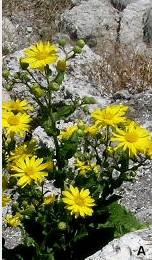 Pat Young reports: Forty one members of American Fossil Federation, Columbus (OH) Rock and Mineral Society, students and faculty from Appalachian State University (NC) and several non-club guests visited PCS with hopes of taking home fossil treasures. This late in the season, megs are considered a bonus — Matt Howard's 3-inch Yorktown tooth was the largest of the day; several smaller ones were also found. Dorothy Kell had a nice Cosmopolitodus hastalis (broad-form) lateral. Uwe Heine, Bill Heim, Kim Greene and Joann Bove showed Notorynchus teeth. Bill and Josh Cooper had Pungo sperm whale teeth, while Barbara Shea and Kristan Cockerill picked tiny ray dermal scutes from the Pungo sands. Pat Hammond found a seal molar (missing one root lobe) while daughter Catherine, celebrated her 18th birthday trip to Aurora. John Everette taught the Pungo sifting technique to Kristan and Andy Heckert (image B). Pat Young reports: Forty one members of American Fossil Federation, Columbus (OH) Rock and Mineral Society, students and faculty from Appalachian State University (NC) and several non-club guests visited PCS with hopes of taking home fossil treasures. This late in the season, megs are considered a bonus — Matt Howard's 3-inch Yorktown tooth was the largest of the day; several smaller ones were also found. Dorothy Kell had a nice Cosmopolitodus hastalis (broad-form) lateral. Uwe Heine, Bill Heim, Kim Greene and Joann Bove showed Notorynchus teeth. Bill and Josh Cooper had Pungo sperm whale teeth, while Barbara Shea and Kristan Cockerill picked tiny ray dermal scutes from the Pungo sands. Pat Hammond found a seal molar (missing one root lobe) while daughter Catherine, celebrated her 18th birthday trip to Aurora. John Everette taught the Pungo sifting technique to Kristan and Andy Heckert (image B).
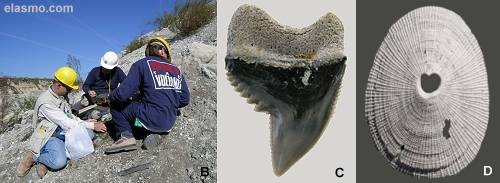
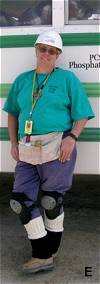 The remaining 30 Friends of the Museum cashed in their rainchecks for a trip on Sunday. Led by Candace Holliday (image E), this enthusiastic group quickly departed for what was hoped to be previously overlooked tooth territory. Knowing Saturday's group had probably scoured the area, the crowd used a hit and run technique - if it was there, pick it up. If not, quickly move to another area and look closely. Several very nice C. hastalis (broad-form) were collected, with Marlyn Allen's upper being the largest (2-1/4"). Jimmy Holton and Eric Seigle found lowers in the 2-inch range. Heather Greer got a great 3" lateral Pungo meg. What Bruce Worf's meg missed in detail was made up in size — a 5-1/2" Pungo re-worked specimen. The Pungo limestone produced a decent 2-1/4" lateral C. chubutensis for Matt Seidel. Jerry Ryan and George Greer found sperm whale teeth. Xan Dubrock brought out a pathological lower Notorynchus and Amy Turner a neat (1") Galeocerdo cuvier (image C) tooth. A surprisng interest is being shown in smaller teeth these days. I saw Rhizoprionodon (Keith Robertson and Candace) and a Paragaleus (Sharron Edwards) teeth. Invert material was best represented by Richard Havens nice specimen of Diodora nucula (keyhole limpet, image D) and Stan Griggs two complete sand dollars (Mellita). The remaining 30 Friends of the Museum cashed in their rainchecks for a trip on Sunday. Led by Candace Holliday (image E), this enthusiastic group quickly departed for what was hoped to be previously overlooked tooth territory. Knowing Saturday's group had probably scoured the area, the crowd used a hit and run technique - if it was there, pick it up. If not, quickly move to another area and look closely. Several very nice C. hastalis (broad-form) were collected, with Marlyn Allen's upper being the largest (2-1/4"). Jimmy Holton and Eric Seigle found lowers in the 2-inch range. Heather Greer got a great 3" lateral Pungo meg. What Bruce Worf's meg missed in detail was made up in size — a 5-1/2" Pungo re-worked specimen. The Pungo limestone produced a decent 2-1/4" lateral C. chubutensis for Matt Seidel. Jerry Ryan and George Greer found sperm whale teeth. Xan Dubrock brought out a pathological lower Notorynchus and Amy Turner a neat (1") Galeocerdo cuvier (image C) tooth. A surprisng interest is being shown in smaller teeth these days. I saw Rhizoprionodon (Keith Robertson and Candace) and a Paragaleus (Sharron Edwards) teeth. Invert material was best represented by Richard Havens nice specimen of Diodora nucula (keyhole limpet, image D) and Stan Griggs two complete sand dollars (Mellita).
Sometimes, when collecting energy wanes, the beauty of a mine becomes more apparent. Fall flowers have been outstanding this season and provide excellent photo opportunities — Wild sunflower (Helianthus sp, image A).
|
| November 05-06, 2005 |
|
Weekend 7: Time to Get the Knees Dirty
Pat Young reports: Saturday saw 32 collectors from the Calvert Marine Museum Fossil Club, College of Charleston (led by Dr. Mike Katuna), and several individuals. A cool morning with heavy fog turned to a high of 78 degrees with pleasant SW breezes all day.
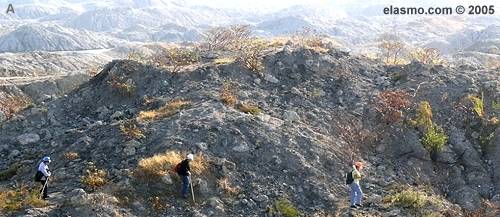
As the Aurora season progresses, the availability of larger, showier specimens usually declines. But first time 'Lee Creekers' Pete Fabry, Chris Holomon, Jen Bradham, John Heinshon, Blaire Morgan and Ramia Kamaria each managed to take home a whale vertebra today. Adam Ranson displayed a 3-inch Pungo megalodon tooth (the largest of the day) while Erin Smith showed off a tiny 1-inch posterior. Mike Katuna and Bruce Hargraves each got great examples (2"+) of Cosmopolitodus hastalis (narrow-form) but many smaller ones were seen. Erin Snow found the only patho tooth of the day, a G. aduncus split-tip. Marc Griffin brought out a 3" sperm whale tooth while partner Kathy Young collected invert material (Trigonostoma sp., Crucibulum lawrencei, and top shells (Calliostoma philanthropum pontoni). Pam Platt and Ken Young each found Angel shark (Squatina) teeth. Bob Platte searched the Pungo for Plinthicus stenodon teeth but also found two lower Notorynchus and Erin Smith two uppers. Linda Zinnikas found several bird bones (yet to be identified) and several pieces of shark cartilage were found by others. Judy Stiles got a very nice Miocene Kentrodontid (dolphin) periotic (image D).
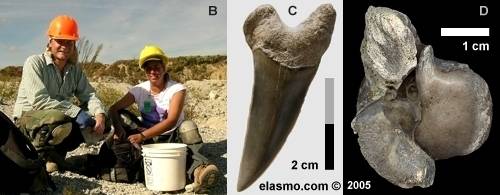
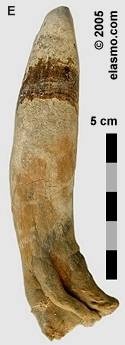 On Sunday, another foggy morning greeted 40 visitors, members of the Delaware Valley Paleontological Society, North Coast Fossil Club (Ohio), NC Aquarium - Fort Fisher, remaining members of the East Coast Fossil Club and several non-club affiliated collectors. Paul Reigle collected a small lateral meg while Mike Keklak brought out a posterior one. Quite a few very nice C. hastalis (narrow) were found including a neat pathologic upper by John Keklak (image C). There seems a never ending supply of nice G. cuvier teeth but most of the other were smaller hemis and carcharhinids. Eric Sadorf managed a Squalodon canine. Jim Supp and Jackie Harris found Notorynchus teeth. Pat Newhauser brought out a bonita hypural and a large anterior section of dolphin snout. Two days of brisk winds has exposed nice inverts including sand dollars (Mellita sp.) found by Donna Cole and Roger Sesterhenn, Trigonostoma sp. (Lana Reigle) and Epitonium sohli (Donna Cole). Several small sperm whale teeth were brought out, but Brian Smarrella found an outstanding example with complete root (image E). The very nice corals, and oyster and pecten shells found at Lee Creek were gathered in abundance by the Ohio group. Paul and Lana Reigle, on their first ever trip to Lee Creek together, show off their finds (image B). On Sunday, another foggy morning greeted 40 visitors, members of the Delaware Valley Paleontological Society, North Coast Fossil Club (Ohio), NC Aquarium - Fort Fisher, remaining members of the East Coast Fossil Club and several non-club affiliated collectors. Paul Reigle collected a small lateral meg while Mike Keklak brought out a posterior one. Quite a few very nice C. hastalis (narrow) were found including a neat pathologic upper by John Keklak (image C). There seems a never ending supply of nice G. cuvier teeth but most of the other were smaller hemis and carcharhinids. Eric Sadorf managed a Squalodon canine. Jim Supp and Jackie Harris found Notorynchus teeth. Pat Newhauser brought out a bonita hypural and a large anterior section of dolphin snout. Two days of brisk winds has exposed nice inverts including sand dollars (Mellita sp.) found by Donna Cole and Roger Sesterhenn, Trigonostoma sp. (Lana Reigle) and Epitonium sohli (Donna Cole). Several small sperm whale teeth were brought out, but Brian Smarrella found an outstanding example with complete root (image E). The very nice corals, and oyster and pecten shells found at Lee Creek were gathered in abundance by the Ohio group. Paul and Lana Reigle, on their first ever trip to Lee Creek together, show off their finds (image B).
The rains have tapered and it's time to think in terms of working to find fossils. Future collectors would be smart to bring knee pads.
|
| October 29-30, 2005 |
|
Weekend 6: Now the Hard Part
Pat Young reports: Saturday's group consisted of members of the National Capitol Fossil Society, North Carolina Shell Club, Educators of Excellence Fossil Club and a group of science teachers from Hampton, Va. Two inches of rain, cooler temps, and frost have kept the mine very wet, making it harder to see the goodies we know are here. John Everette managed to find a very pathological posterior C. megalodon (ref. image C) that had a labially directed cusp. Kathleen Harrison had a nice lamnid shark vertebra that measured 2-1/4 inches in diameter and height. Sharron Edwards and Heather Greer each found Pungo megs (2-13/16" & 1-3/4"). Heather also brought out a 4-1/4" heartbreaker (3/4s of a meg). Quite a few Notorynchus teeth surfaced, most likely due to closer collecting techniques. Other tooth finds were the usual small suspects.
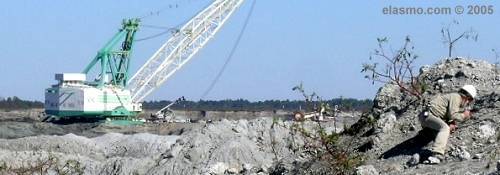
On Sunday, a hard frost quickly turned into a warm sunny day as 39 members of the NCFC gathered for their rain make-up date. Still wet soils and longer winter shadows are making it harder to see and the day's collecting reflected that. Teresa McGrady, a Lee Creek newcomer, found the largest meg of the day, a 5-inch anterior which, unfortunately, had been stepped on and was split in the middle. George Powell had a nice 2-3/4" Pungo lateral, Xan Dubrock returned with a tan 2-1/2" lower (ref. image A) and Jodie McDaniel recovered a nice posterior (1-1/8") tooth. Dick Marshall managed to scoop up a tiny 3/16" posterior specimen. Heather Power showed off a Cosmopolitodus hastalis lateral (2-1/4") and also a large porpoise periotic bone. Carcharodon carcharias teeth were found by Jack Gollahon (2-1/4") and Charlie Kanupp (a shiny 1-1/4" specimen). G.cuvier teeth continue to surface in great numbers.

A talley of both days revealed some nice 'other finds". Anita McKnight found an Imperial Venus (Chione latilirata) clam shell (ref. image B). It's been a long time since one of these James City shells has been found in Aurora. John Timmerman found a nice Squalodon incisor, Daniel Beane a large marlin dorsal spine, Jessie Fuhs two lovely ray dermal denticles and Cindy Muston a crocodile tooth. Rick Bennett's fossil skull from a herring-like fish was admired by all.
Those having the best finds of both days returned to the bus with muddy knees and that technique will serve well in the coming months.
|
| October 22-23, 2005 |
|
Weekend 5: Weather or Not
During a weekend that produced continuous rains along the East Coast, there were two breaks in North Carolina's coastal weather which coincided with the PCS collecting slots. These Moses-like partings of the rain allowed a weekend of decent-collecting. The waters were high and tailings subsequently truncated (images A-C), however warm temperatures and partially sunny skies made for comfortable collecting conditions.
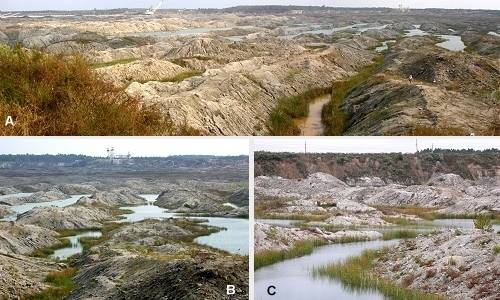
 Pat Young reports: Excitement ran to high levels as this weekend's fossil collectors learned they would be the first to explore newly rain-washed mine tailings. With 42 collectors each day, members of the Aurora Fossil Club, East Coast Fossil Club and the North Carolina Museum of Natural Science got Saturday's slots while Sunday's group consisted of a group of science educators from Stafford County, VA (lead by Roger Brown) and several non-club affiliated collectors. Anne Lineberry, her brother Scott and sister, Nancy Brown, met for a mini family reunion of fossil collecting (image D). Special guests for the day included Dr. Lauck Ward and Jim Bourdon. Our new bus route takes us near the huge working draglines. This is the closest most of us will ever get to these huge machines -- the show is quite impressive.
Pat Young reports: Excitement ran to high levels as this weekend's fossil collectors learned they would be the first to explore newly rain-washed mine tailings. With 42 collectors each day, members of the Aurora Fossil Club, East Coast Fossil Club and the North Carolina Museum of Natural Science got Saturday's slots while Sunday's group consisted of a group of science educators from Stafford County, VA (lead by Roger Brown) and several non-club affiliated collectors. Anne Lineberry, her brother Scott and sister, Nancy Brown, met for a mini family reunion of fossil collecting (image D). Special guests for the day included Dr. Lauck Ward and Jim Bourdon. Our new bus route takes us near the huge working draglines. This is the closest most of us will ever get to these huge machines -- the show is quite impressive.
Most of Saturday's group quickly dispersed to the Yorktown sediments in search of Carcharocles megalodon teeth. Carey Hubbard brought out an impressive 3-5/8 inch upper A1, the largest tooth of the day. Others (including Pungo morpho-species) were found by Debbie Huston (3-3/8"), Duane Hubbard (3"), Andy Albright (2"), Brian Roberts (2-1/4" and a very nice 1-3/8" posterior tooth) and Jamie Hartsell who found four, including a beautiful Pungo lower (2-5/8"). Howie Cohn found an interesting specimen that bus-side appeared to be a small meg posterior (image H), but under greater magnification, failed to live-up to that expectation. (We will attempt to provide a proper identification in a later news column.)
Several large lower Cosmopolitodus hastalis were seen, but Sharron Edwards' (2-1/4", image D) and Scott Lineberry's (2") narrow forms were particularly pretty. Duane Varnum located a Notorynchus symphyseal. Pathological teeth were reported by Howie Cohn (Notorynchus parasymphyseal) and Ed Horlick (Carcharhinus brachyurus, image F). Ed also found an Isurus retroflexus lateral. Large Galeocerdo cuvier teeth were abundant as were most species of smaller teeth. Six Carcharodon carcharias and one Squatina tooth were reported. Russell Willard and John Partin showed off Notorynchus lowers.
Sunday's group (less 'meg-obsessed') had teachers filling buckets and backpacks to the brim with classroom supplies. Most of this group were first-time collectors and their closer-to-the-ground approach led to some nice smaller finds. Karen Nagy showed a large upper Notorynchus, Ginger Beach an especially nice Notorynchus lower, Mike Pratte a lateral C. chubutensis (1-3/4"), and Linda Gayle dug up an Isurus retroflexus while waiting for the bus. Kim Greene reported a 2-inch lower C. hastalis (broad form) tooth but many smaller C. hastalis teeth were also found. One Echinorhinus blakei tooth was recovered by Ken Young.
A combination of both days collecting produced abundant 'other fossils'. Sam Schmidt's 1-3/4" Fratercula aff. arctica (puffin) femur (image E) was especially noteworthy. Other finds included those by: John Partin (whale tooth), Nancy Brown (Mellita sp sand dollar), Duane Varnum (Squalodon canine), Carey Hubbard (two seal incisors) and Duane Hubbard (Squalodon incisor). Anne Goewert spent the day collecting invertebrate material for research; "Way to go, Anne! Thanks!"
|
| October 15-16, 2005 |
|
Weekend 4: Still Closed
The severe rains that battered the East Coast continued to take their toll on collecting. This weekend, the continuing effects of the rain were well anticipated, allowing collectors to be notified in advance that there would be no access. For those scheduled for Weekend 5, one should take Pat's advice of a week ago and watch the weather. There are already projections that remnants of Wilma could be in the area. Additional rain may set back attempts to restore the collecting area to a visitor-safe condition.
|
| October 08-09, 2005 |
|
Weekend 3: Rained Out
Pat Young reports: The lines between bravery and foolhardiness can be hard to define. Fossil hunters are sometimes guilty of both. But obsessive is the only term to adequately describe the 22 hardy collectors who showed up in a drenching rainstorm at the PCS parking lot on Saturday morning. The visitors, some coming from as far away as Texas, South Carolina, and California, stood hopeful for word that the mine would be open to them. Unfortunately, the previous 12 hours had produced over 7 inches of rain and conditions were determined to be too treacherous for navigation to the pit. The rains continued throughout the day until nearly 3pm, producing another 5 inches. Sunday's group would also have to wait for their chance at a later date.
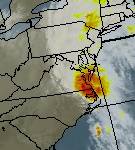 Most people asked why we could not collect in the rain as in previous times. 12 inches of rain in less than 24 hours is not a normal shower. The mine ramp is mostly clay which can be very slippery. Just getting to the collecting area could be a hair-raising experience and getting back up the ramp at the end of the day would have been a nearly impossible feat. Most collectors said they had not checked the weather before they left home. To save one's self trouble later, I'd recommend that the Weather Channel always be checked a few days before attempting a long distance trip to PCS. If possible, also check the weather listings online for Washington, NC or New Bern, NC.
Most people asked why we could not collect in the rain as in previous times. 12 inches of rain in less than 24 hours is not a normal shower. The mine ramp is mostly clay which can be very slippery. Just getting to the collecting area could be a hair-raising experience and getting back up the ramp at the end of the day would have been a nearly impossible feat. Most collectors said they had not checked the weather before they left home. To save one's self trouble later, I'd recommend that the Weather Channel always be checked a few days before attempting a long distance trip to PCS. If possible, also check the weather listings online for Washington, NC or New Bern, NC.
In spite of sometimes pouring rain, the parking lot chatter was relaxed and friendly and unhurried. We used the time to catch up on the activities of others and marvel at our resilience. It was a real fun time.
|
| October 01-02, 2005 |
|
Weekend 2: A Week Without Rain
Pat Young reports: On Saturday, thirty-three members of the Museum Friends departed the parking lot under clear sunny skies with a breezy temperature of 70-degrees.
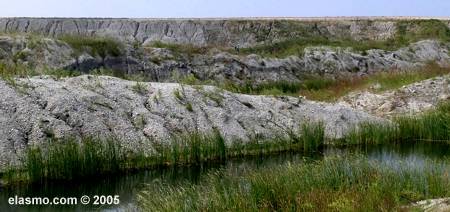
George Powell, only minutes after descending the mine ramp, managed to find a 5-1/2 inch meg. Although it was a bit of a dinger, it was a great inspiration. Stan Newquist brought in the next largest, a 2-7/8" lower; other megs were found by Dave Grabda (2-1/4" in matrix & 1-1/2" lateral), Kim Greene (2-1/4" chubutensis found in the road), Jeff Sparks (1-7/8 & 1") and Debbie Burdette, a very nice 1-3/4" lateral. Several smaller Pungo specimens were seen. Cosmopolitodus hastalis teeth were mostly small, although Gene Yates and Tom Savisky each gathered narrow-form teeth in the two-inch range. Betsy Hallman gave up otolith hunting to find a nice specimen in matrix. Most of the broad-form hastalis appeared to be juvenile teeth. Notorynchus collectors fared well with good finds made by Kevin Dye, John Bunch, Jeff Sparks, Richard Aultman, Barbara Shea (upr and lwr), Nancy Collins (upr) and others. Sophie Homesy managed a neat little black Echinorhinus tooth and George Klein a 1-1/2" Carcharodon carcharias. Nancy Collins found a pathologic hastalis; the crown was bent lingually nearly 90-degrees.

Sunday's twenty-five collectors had equally good weather and perhaps a heightened awareness of the competition from Saturday's collectors. Most hunted until time for the bus to leave, making picture-taking difficult. Bob Dann, Mary Kay Furmisky and Heather Greer each had 2-3/4 inch megs. Melany Furmisky found a 2-1/2" one and Ken Arnold a very pretty lower Pungo chubutensis (2"). Brian Burdette picked up a sharp one-inch C. carcharias (UA1) and Andy Overly a 1-1/2" re-worked specimen. C. hastalis (broad-form) were well represented by Tom Burdette's 2-1/2" UA1, Doug Slezak's 2-inch lateral and others by Andy Overly (2"), Candace Holliday and Heather Greer. Narrow-form hastalis (mostly lowers) were found by Barb Roder (2-1/4"),Roberta Dann(2"), Dan Furmisky (2") and MJ Bertsch (1-3/4"). Rita McDaniel brought out a Hexanchus upper (ref iamge A) and a Carcharoides catticus. Candace picked an Echinorhinus and Heather Greer an upper Nortorynchus (ref image C); several lowers were also found.
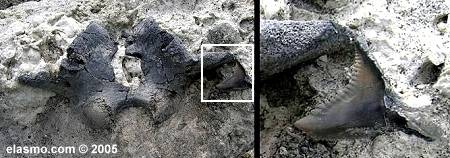
Two days collecting produced some interesting non-tooth finds as well. Judy Stiles, Melany Firmisky, Keith Robertson and Ernest Klatt each brought out sand dollars (Mellita sp., ref image C). Other fossils included a marlin dentary (George Klein), partial seal jaw with three teeth (Judy Stiles), Pelagornis sp (toothed bird) partial dentary (Dave Sanderson), Squalodon teeth (Heather Greer & Jim White) and a seal astragalus (Ron Edwards). Matt Wojtko hauled out a large chunk of limestone containing a cetacean exoccipital bone and Hemipristis tooth (ref image)
|
| September 24-25, 2005 |
|
Weekend 1: The Fun Begins
Pat Young reports: Forty-three members of the Friends of the Museum started the fall season at PCS with Candace driving the bus. Clear skies and mid-seventies temps were a welcome relief from the more normal heat we had been experiencing. After having the collecting area pointed out to them, most collectors headed for the far reaches of the mine, in hopes of staking a claim to Yorktown sediments. First day collectors are a serious bunch and socializing is not a top priority; I'd have to wait until this group got back to the bus to hear what had been found that day. Unfortunately, as those due to leave on the 2pm bus arrived, the skies emptied torrential rains on all of us. Needless to say, the day's list was mostly by word of mouth and there are bound to be omissions.
Gary Grimsley reported having found a 4-1/2" C. megalodon — the day's largest. Bill Heim spotted one on the ramp before we got into the mine! Jason Kowinsky found two nice tan-colored ones in Pungo matrix. Others were found by BJ Blake (3"), Bob Belcher (1 x 1/2" posterior), Ira Guy (2") and Roxada Story (2-1/2"), she also found two Carcharodon carcharias teeth. Ron Edwards and Eric Sadorf found large Parotodus benedini, each with a missing root lobe. Chuck Ball found a Hexanchus lower, albeit in two pieces.

Sunday's group of 33 Friends had the full benefit of the previous day's rain. This meg-motivated crowd also headed toward the rear Yorktown soils and was well rewarded. Matt Rever, a first-time land collector, managed to get the days largest complete meg — 4-3/8 (ref image D)". Others were had by Mel Gulotta (4 & 2-1/2"), Matt Howard (4"), John Miller (3-3/8" chub, image E), Doug Chaussee (2-1/2 & 1-7/8') and Jeff Greaser (2"). Quite a few smaller ones were seen. Joanna Bove's meg (4-1/2") was missing a root lobe. Sharron Edwards had the smallest one, a symphyseal measuring only 3/8" high (image C). A beautifully colored three-inch C. hastalis (broad-form, image F), found by Jeff Greaser, generated lots of attention. John Adams' tiny Galeocerdo aduncus symphyseal (image A) was quite a curiosity to most of us.

Other notable finds are combined from both days collecting ventures. Ira Guy found a 1-1/2" crocodile tooth in Pungo matrix, Lester Hall a 2-inch C. carcharias, Paul Sangeorzan a very nice black C. carcharias encrusted with coral, Doug Chaussee a baseball-sized piece of 'amber', Eric Sadorf a shark rostral node (image B), Jim White a partial whale jaw with three teeth, Paul Murdoch a 7/8" C. carcharias (image G) as well as Squalodon molars and incisors, Richard Habron a shark denticle, Marco Gulotta, Sr. a black Alopias grandis, Ken Young a tooth that could not be identified due to gross pathology, and Daryl Serafin a 6-1/4" sperm whale tooth. Notorynchus teeth seemed surprisingly abundant. One meg tooth was spotted in the dozer track, after having been walked over by many.
It was a fun first weekend of collecting.
|
| September 20, 2005 |
|
The Stakes Are Set
Five inches of rain this last week surely hasn't hurt collecting conditions. Pat Young was asked to provide a pre-season assessment of collecting conditions; she wrote:
I had the chance to put down stakes for the fall season today. Although I did no scouting, the view from the road looks promising.
The area is essentially the same as last year but has been somewhat extended toward the rear. I saw more lower Yorktown sediments in the farthest areas than was available in the areas near the high-wall. The two hills beyond the left ramp are still available but the areas to the right of the right-hand ramp (shell heaven) are now off limits due to water. A bulldozer track, marked by stakes, runs the entire perimeter of the collecting area. Some hills will require backtracking to find an exit and extra time should be allowed for that. Being so near a high wall has allowed water to rise somewhat in the previously existing water holes, but should present no problem if one follows the 25-foot rule. Some areas that were previously considered too steep have rain-washed to a collectible slope and have now been opened to collecting. However, we should still remember that we are collecting a 'scour area' and some may want to refocus their collecting bias to include more than 'Bubba Megs'. I think fall season collecting will be more prolific for vertebrate fossils although shell collectors may experience famine conditions.
It is still very hot and humid here. I can't impress enough the need to bring more water than you think you'll need. Also, we'll likely have to take two buses this season, so collectors would be wise to arrive a bit early to facilitate the paperwork and get into the mine on time.
For now, there are no new rules for this season, but as a reminder:
Photo ID required.
Steel-toed footwear required.
Hard hat must be worn at all times when in the mine.
No sleeveless shirts or tank-tops.
Long trousers (no dresses or shorts).
|
| September 15, 2005 |
|
Slots awarded
 This past week, awarded-slots were sent out. The season will begin September 24th with the first of the Friends groups. Non-Friends invites will likely start Oct 9th or the following Saturday. As I write this Ophelia is pounding the mine -- Ken & Pat lost power hours ago. This past week, awarded-slots were sent out. The season will begin September 24th with the first of the Friends groups. Non-Friends invites will likely start Oct 9th or the following Saturday. As I write this Ophelia is pounding the mine -- Ken & Pat lost power hours ago.
If you haven't visited yet, be sure to check-out the new Mako tooth-set slide-show.
|
| August 12, 2005 |
|
Fall Season Confirmed
A Fall collecting season has finally been confirmed. No dates have been established, but like last Fall, it will likely commence in late September with initial slots going to the "Friends". It will be 6-weeks before any flags are placed, but the collecting area should be similar to this Spring's.
|
| July 31, 2005 |
|
Fall Season Requests
The PCS Public Affairs Dept. has announced the details for submitting requests for Fall 2005 access.
Although there is not yet confirmation of a Fall season, Curtis Ormond, Sr. will begin accepting email requests from collectors commencing Monday morning August 15th at 8:00 am and will continue until August 30th. No emails submitted before 8:00 am will be considered. If a club has already sent in a request, they must re-submit them within these dates and times.
|
|
|